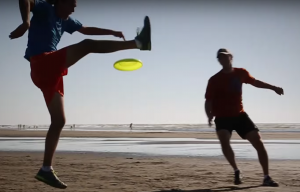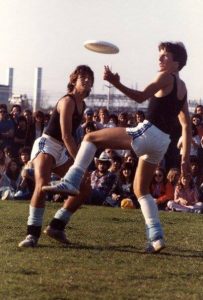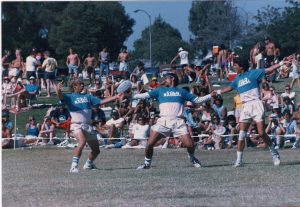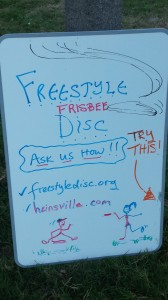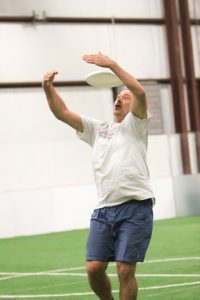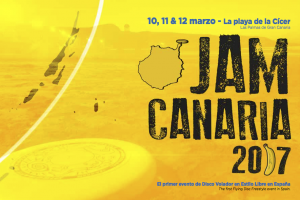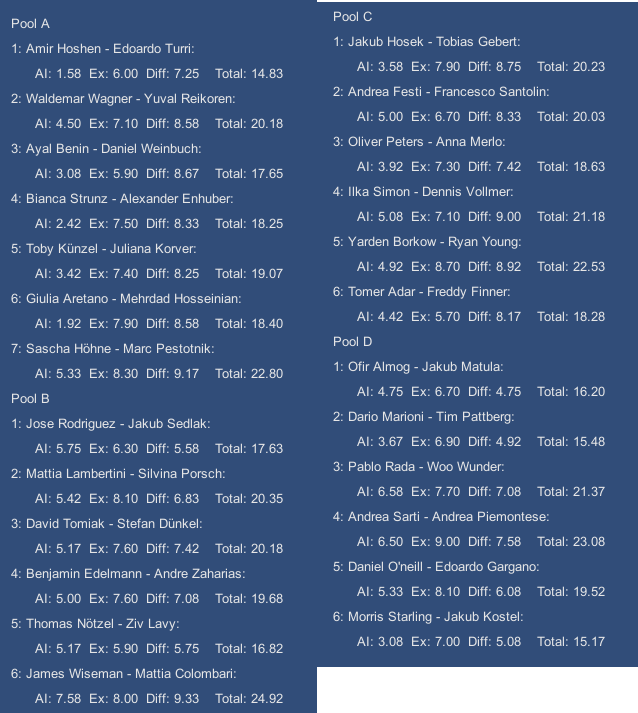- A frisbee trick the involves allowing a disc in flight to travel under the leg without touching the disc. For a leg over to be “official” either another player must touch the disc after the leg over or the player performing the leg over must perform an additional restriction before touching the disc. An example of the former is a leg over to someone else’s catch. An example of the latter would be a leg over behind the back catch. A leg over is not to be confused with an under the leg trick in which the disc travels under the leg and is then touched by the same player with no other restriction. For example an under the leg catch or under the leg set are not technically leg overs.
Author: Jake
Episode 7 – Donnie Rhodes and Allen Elliott – The Road to Becoming ’81 Rose Bowl Champions
Podcast: Play in new window | Download
We got a chance to talk with Allen Elliott and Donnie Rhodes. In this episode they talk about how the started playing, how they teamed up, and how they prepared for the ’81 Rose Bowl.
- Hear how all-time greats Allen Elliott, Donnie Rhodes, and Jeff Felberbaum joined forces to win the Rose Bowl in 1981.
- Donnie shares how he grew up “Dolly Parton poor” in Appalachia and how Frisbee became such a huge escape from his daily life.
- Ultimately, it was the many dance classes, generous mentoring, and a pure love of the sport, that drove Donnie’s Frisbee trajectory.
- Watch their semi Finals performance
- Watch the Semis and Finals edited together to Pinball Wizard, from a different camera angle.
Poll: When you compete, how much of your routine is planned?
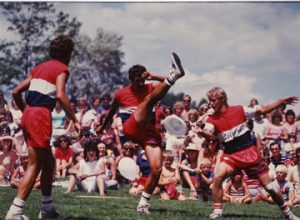 When I competed in my first event in 1996, The Beast took me under his wing and taught me how to think about competition. Since we had only met the day before we came up with 3 co-ops for the routine. That was 3 more than I had ever come up with before. From there, my routine preparation slowly grew towards more choreography.
When I competed in my first event in 1996, The Beast took me under his wing and taught me how to think about competition. Since we had only met the day before we came up with 3 co-ops for the routine. That was 3 more than I had ever come up with before. From there, my routine preparation slowly grew towards more choreography.
At the 1999 FPA World Championships, Matt and I had 4 opening co-ops. Then we went “spon” until a “half way” time call. We had 2 co-ops for that. Then “spon”, finishing up with 2 co-ops at a “30 seconds” time call.
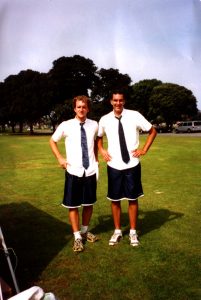 At the 2001 FPA World Championships, Matt and I had every moment of the routine planned out, with the exception of our 4 indies. No time calls where needed. At the time, that was our best finish, 4th.
At the 2001 FPA World Championships, Matt and I had every moment of the routine planned out, with the exception of our 4 indies. No time calls where needed. At the time, that was our best finish, 4th.
Based on that experience, it might seem that fully choreographed routines are the way to the top. However, I have also had many successes that were 100% spontaneous. Matt and my first win at California states, for example, or recently at Frisbeer 2013. Never won and FPA worlds without choreography though.
After listening to Bill talk about the Coloradicals journey towards choreography, hearing the various approaches of the teams at Frisbeer 2017, and reflecting upon my own history, a question comes to mind.
When you compete, how much of your routine is planned ahead of time?
[poll id=”7″]
Tell us in the comments, do you think choreography increases a team’s chances of doing well?
Bad Attitude
In this video, I explain how I catch a bad attitude. For another example, check out Lori’s video. The catch is useful one because it uses a unique body position where the player stands upright on one leg and catches the disc around the ankle of the other leg. This gives it visual appeal from a variety perspective.
 Bad attitude is named after the dance position called attitude, except it’s a bad version of it. I am the perfect example of how bad the attitude can be. My flexibility is limited so the window to make the catch is very small. Besides stretching, what helps me are two things. First I stand on, or jump from one leg and then bend at the hip to bring the catching hip upwards. This means I don’t have to bend the catching hip as far back. Next, I rotate so the catching hip forward which means I can get my hand around my foot and ankle just a little easier.
Bad attitude is named after the dance position called attitude, except it’s a bad version of it. I am the perfect example of how bad the attitude can be. My flexibility is limited so the window to make the catch is very small. Besides stretching, what helps me are two things. First I stand on, or jump from one leg and then bend at the hip to bring the catching hip upwards. This means I don’t have to bend the catching hip as far back. Next, I rotate so the catching hip forward which means I can get my hand around my foot and ankle just a little easier.
 Of course when I do it, it’s not so pretty. But, when done properly, it can be quite beautiful. Here’s Sue Straight showing us a proper bad attitude. Don’t worry if you don’t look like Sue. The bad attitude is a fun, explosive, and surprising catch that will grab attention no matter your form.
Of course when I do it, it’s not so pretty. But, when done properly, it can be quite beautiful. Here’s Sue Straight showing us a proper bad attitude. Don’t worry if you don’t look like Sue. The bad attitude is a fun, explosive, and surprising catch that will grab attention no matter your form.
Episode 6: Birth of the Coloradicals
Podcast: Play in new window | Download
We interview Bill Wright and learn about the birth of the Coloradicals, the iconic Freestyle team of Bill Wright, Rick Castiglia, and Doug Brannigan.
- Find out the origin of the Coloradicals & the inception of the delay.
- The birth of the Blur, and spinning catches.
- For you youngsters, find out how in heck you set up your music in the 1970’s.
- Hear how choreographed routines evolved for this team and listen to Bill share his memories about qualifying (and winning!) the 1980 Rose Bowl as a college senior.
- “Wow, I am a world Frisbee champion from Colorado. That’s amazing!”
Poll: Audience for the Jam
There was a summer when the Portland crew was determined to find a new jammer. We put up a sign at every jam and made focused efforts to talk to anyone who stopped. Yet for all the effort, no new people became jammers. However, there was some success. We talked to many people. Some people did learn what freestyle was. Another couple borrowed a disc and played catch on their own for 30 minutes or so. I taught at least one boy to air brush a whiz ring. I’m afraid to say that since that summer we’ve lost some of our motivation to talk to those who stop and watch.
This weeks poll: When someone stops to watch the jam, do you stop to engage with them?
[poll id=”6″]
If you are a person who engages, what do you say? Has anyone had success bringing in a new jammer this way?
Word of the Day – Hoop
- A frisbee trick that involves creating a hoop or circle by touching the fingertips together and extending the elbows. Then a disc in flight travels through the hoop. The disc in not touched by the player.
- Sometimes used to describe any class of tricks that involve interacting with the disc without touching it.
Jam Canaria 2017 – Results!
- James Wiseman Mattia Colombari
- Andrea Sarti Andrea Piemontese
- Sascha Höhne Marc Pestotnik
- Waldemar Wagner Yuval Reikoren
- Yarden Borkow Ryan Young
- Ilka Simon Dennis Vollmer
- Pablo Rada Woo Wunder
- Mattia Lambertini Silvina Porsch
[paypal_donation_button]
Jam Canaria Semi results and Finals Pool
Top 2 from each pool make the finals. Finals Pool. Watch Live.
Mattia Lambertini Silvina Porsch
Waldemar Wagner Yuval Reikoren
Pablo Rada Woo Wunder
Ilka Simon Dennis Vollmer
Andrea Sarti Andrea Piemontese
Yarden Borkow Ryan Young
James Wiseman Mattia Colombari
Sascha Höhne Marc Pestotnik
Episode 5 – Featuring the Frisbeer Cup 2017 Winners
Podcast: Play in new window | Download
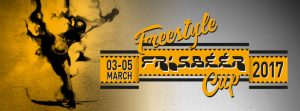 In this episode we talk with all the winners from Frisbeer Cup 2017. See all the results here.
In this episode we talk with all the winners from Frisbeer Cup 2017. See all the results here.
- Mehrdad Hosseinian – Paul Kenny – Open Pairs
- Ilka Simon – Paul Kenny – Mixed Pairs
- Ilka Simon – Anna Merlo – Women’s Pairs
- Rick LeBau – Juliana Korver – Challenger Pairs
- Naïm Megassabi – Steffen Verstichel – Battle
- coming soon
- Florian Hess – Alex Leist – Christian Lamred – CoOp
- Watch the routine
- This team is known for their routine planning and choreography. In this article, Arthur Coddington explains how to put together a routine.



